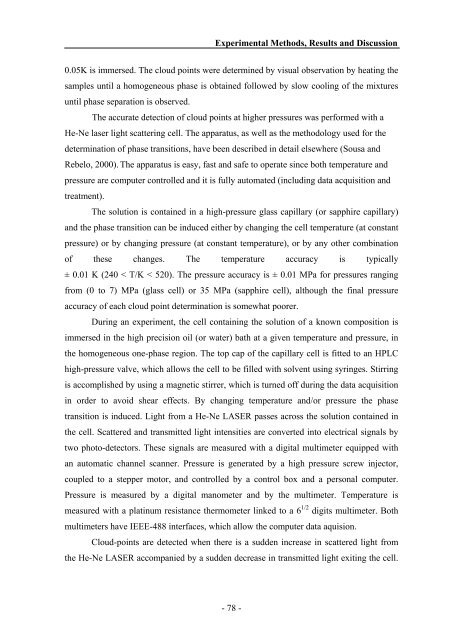n - PATh :.: Process and Product Applied Thermodynamics research ...
n - PATh :.: Process and Product Applied Thermodynamics research ...
n - PATh :.: Process and Product Applied Thermodynamics research ...
Create successful ePaper yourself
Turn your PDF publications into a flip-book with our unique Google optimized e-Paper software.
Experimental Methods, Results <strong>and</strong> Discussion<br />
0.05K is immersed. The cloud points were determined by visual observation by heating the<br />
samples until a homogeneous phase is obtained followed by slow cooling of the mixtures<br />
until phase separation is observed.<br />
The accurate detection of cloud points at higher pressures was performed with a<br />
He-Ne laser light scattering cell. The apparatus, as well as the methodology used for the<br />
determination of phase transitions, have been described in detail elsewhere (Sousa <strong>and</strong><br />
Rebelo, 2000). The apparatus is easy, fast <strong>and</strong> safe to operate since both temperature <strong>and</strong><br />
pressure are computer controlled <strong>and</strong> it is fully automated (including data acquisition <strong>and</strong><br />
treatment).<br />
The solution is contained in a high-pressure glass capillary (or sapphire capillary)<br />
<strong>and</strong> the phase transition can be induced either by changing the cell temperature (at constant<br />
pressure) or by changing pressure (at constant temperature), or by any other combination<br />
of these changes. The temperature accuracy is typically<br />
± 0.01 K (240 < T/K < 520). The pressure accuracy is ± 0.01 MPa for pressures ranging<br />
from (0 to 7) MPa (glass cell) or 35 MPa (sapphire cell), although the final pressure<br />
accuracy of each cloud point determination is somewhat poorer.<br />
During an experiment, the cell containing the solution of a known composition is<br />
immersed in the high precision oil (or water) bath at a given temperature <strong>and</strong> pressure, in<br />
the homogeneous one-phase region. The top cap of the capillary cell is fitted to an HPLC<br />
high-pressure valve, which allows the cell to be filled with solvent using syringes. Stirring<br />
is accomplished by using a magnetic stirrer, which is turned off during the data acquisition<br />
in order to avoid shear effects. By changing temperature <strong>and</strong>/or pressure the phase<br />
transition is induced. Light from a He-Ne LASER passes across the solution contained in<br />
the cell. Scattered <strong>and</strong> transmitted light intensities are converted into electrical signals by<br />
two photo-detectors. These signals are measured with a digital multimeter equipped with<br />
an automatic channel scanner. Pressure is generated by a high pressure screw injector,<br />
coupled to a stepper motor, <strong>and</strong> controlled by a control box <strong>and</strong> a personal computer.<br />
Pressure is measured by a digital manometer <strong>and</strong> by the multimeter. Temperature is<br />
measured with a platinum resistance thermometer linked to a 6 1/2 digits multimeter. Both<br />
multimeters have IEEE-488 interfaces, which allow the computer data aquision.<br />
Cloud-points are detected when there is a sudden increase in scattered light from<br />
the He-Ne LASER accompanied by a sudden decrease in transmitted light exiting the cell.<br />
- 78 -



